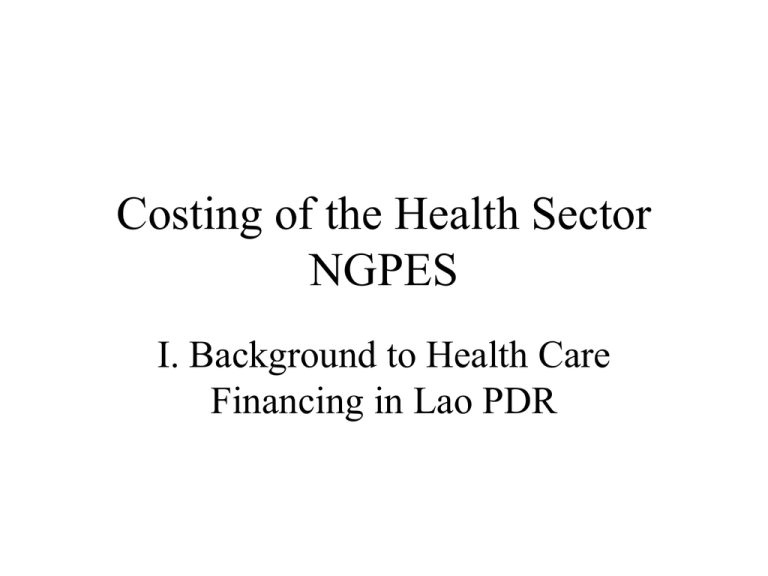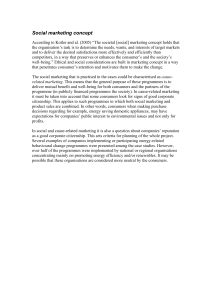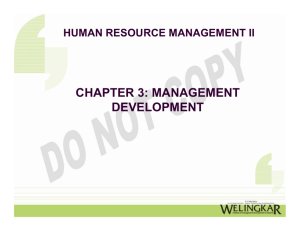Costing of the Health Sector NGPES
advertisement

Costing of the Health Sector NGPES I. Background to Health Care Financing in Lao PDR Health NGPES • Twelve strategic programmes • None of them are perfectly implemented today • All probably need more resource, both financial and human • To understand future financing, you need to know the current situation Health Financing in Laos • Total health spending is about 120,000 kip per year per person – 56% from households – 9% from Lao government • 80% of this goes to salaries – 35% from donors and NGO’s Household Expenditure • 60% is completely private – private pharmacies and private services • 40% is for paying fees in public institutions – cost sharing Recurrent Budgets of Hospitals Depend on User Fees • Central hospitals – 74-83% • Provincial Hospitals – 48-75% • District Hospitals – more variation – but if busy – 52-68% Exemptions from fees are few compared to the poverty rates • Central – 6.1-7.5% exempted • Provincial – 0.1 – 11.9% exempted • District - 0.5% - 67% exempted Summary of Health Care Financing • Total health spending is highly dependent on household expenditure • Public expenditure is highly donor dependent • Public institutions are highly dependent on user fees • Exemptions from user fees are less than the prevailing poverty rates • Result is Lao people use health care late and less than what is ideal Costing of Health Sector NGPES II. Methods and Issues Whose perspective or point of view? • Government • Donors • Households Suggest • Government and Donor Together But • Always evaluate what the effect will be on household expenditure also What is the scope? • • • • • National – entire health system, or 47 poorest districts, or 74 poor districts, or 10 highest priority districts? Separate services for poor not efficient or desirable • Difficult to cost services only for the poor Costing Methods • Ground up - it is appealing, but a very large exercise to go to each district/province and do an individual costing • International norms • Individual programme costs - usually from smaller areas than whole nation, but take these and multiply for national coverage Programmes • I. Information Education and Communication Data Sources • Many programmes have a small IEC budget, no single comprehensive programme Programmes • II. Expansion of the service network and health promotion in remote areas Data Sources • Costing studies on health centres and hospitals MOH/WHO and SSO, costs of new and renovated health centres and hospitals from ADB/WB projects Programmes Data Sources • III. Upgrade skills of health staff and increase the number of staff from ethnic minorities • WB study on medical (doctor) education • Nursing school projects - JICA • PHC Worker Project ADB/PHC project • VHV training costs • Refresher course costs - MOH/JICA database Programmes • IV. Promotion of maternal and child health Data Sources • RH projects UNFPA/MOH • (Is upgrading of facility included in Programme II?) Programmes • V. Immunization for women and children Data Sources • Financial sustainability plan GAVI Programmes Data Sources • VI. Water supply and environmental health • Average costs per borehole, protected well, gravity scheme Naam Saat (SIDA, UNICEF, WB) Programmes • VII. Communicable disease control – – – – – – Malaria Dengue ADD-Cholera TB Intestinal parasites Surveillance - general Data Sources • Malaria projects - EU, Global Fund • Dengue proposals WHO • TB - Global Fund • Parasites - WHO proposal • Surveillance - MBDS, WHO, Programmes Data Sources • VIII. HIV/AIDS/STD Control • HIV/AIDS/STD Action Plan • Global Fund proposals Programmes • IX. Drug revolving fund expansion Data Sources • FDD of MOH average start-up costs for DRF, also available from PHC/ADB project Programmes Data Sources • X. Improved food and drug safety • Drug - SIDA and WHO projects • Food - FAO and WHO projects – Drug safety – Food safety Programmes • XI. Promotion of traditional medicine Data Sources • ? Programmes Data Sources • XII. Strengthened financing, management, quality assurance, and legal framework • Cost of community insurance pilots, mgmt training costs from PHC/ADB and other projects Costing of Health Sector NGPES III. Example – “National Immunization Programme Financial Sustainability Plan’ – Nov. 2002 Background • Immunization – known to be efficacious and cost-effective • Coverage rates in Lao PDR are not ideal – around 50% when 85% is desired • Immunization is highly donor dependent • GAVI – Global Alliance for Vaccines Initiative – new money, new vaccines, new methods – but how to sustain? Summary of Costs (US$) Item 1999 2001 Operational Costs Supplemental Activity Capital Costs 956,856 196,927 211,292 Total Nat. Imm. Prog. 1,365,075 1,568,166 1,020,932 386,539 160,696 Availability of Cost Information • Partly available, but difficult and time consuming to find • Problems – Accounting systems vary depending on the source of the funds – Donor and in-kind contributions often not known to implementers Financing of Immunization Source 1999 2001 Government UNICEF WHO/AusAid JICA Other GAVI 5.5% 42.1% 7.7% 43.0% 1.8% 0% 4.9% 23.3% 13.8% 34.4% 2.6% 21.0% Projections Done • Assuming that the new and more vaccine is introduced nationwide • Assuming that certain costs go up to increase coverage from 50% to required 85% (mainly per diems for outreach) • Modest capital investment – new fridges • Eventually supplemental activities stop Projections of Requirements 2003 2004 2005 2006 2007 3,157,462 3,604,082 4,310,624 3,593,540 3,772,383 Total 18,438,091 Why are costs going up rapidly? • New vaccine to prevent Hepatitis B (a major cause of liver cancer) has been introduced and it is expensive. It is cost effective, but the benefit comes in cancers prevented 20-30 years from now. Who pays? • It is more expensive to reach remote populations than semi-urban pops. Projection Assumptions • Economic growth and government budget grows – 6-8% • Major donors continue support at same level with growth for inflation • In most optimistic projection – HIPC is assumed, which is not a safe assumption Projections of Funding Gap 2003 2004 2005 2006 2007 724,988 1,274,307 1,342,411 1,229,889 2,143,129 Total 6,714,523 Summary – Secured funds and funding gap Million $ Needs Secured Gap Total $ 17.9 $ 11.2 $ 6.7 Ann. Ave. $ 3.6 $ 2.2 $ 1.3 Total $ 11.8 $ 0.9 $ 10.9 Ann.Ave. $ 2.4 $ 0.2 $ 2003-07 2008-10 2.2 Funding and Gap- Optimistic on future donors Millions Probable Gap Possible Gap 2003-07 Total $ 13.9 $ 4.0 $ 14.0 $ 3.9 Ann.Ave $ 2.8 $ 0.8 $ 2.8 $ 0.6 $ 5.2 $ 6.5 $ 7.5 $ 4.3 Ann.Ave $ 1.0 $ 1.3 $1.5 $0.7 2008-10 Total Summary - EPI • 2003-07, even with optimistic projections has a $600,000 gap per year in funding • As time lengthens, there is more insecurity about EPI funding Issues • A projection done looking at EPI only – could efficiencies be made by reorganization? • Is it sensible to fund vital programmes, one at a time, separately? • Poorest districts – hardest to reach, most expensive to immunize – how much to concentrate effort there when easier to reach areas have not yet reached acceptable immunization rates? Thank You






